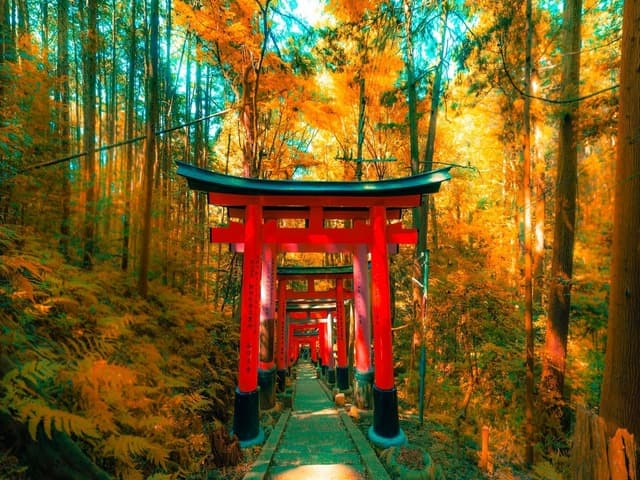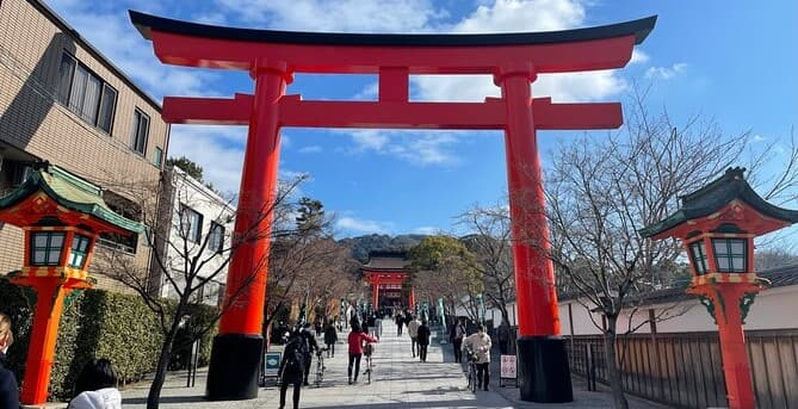Note: Here, we introduce a sightseeing tour that is accommodating to Muslims. However, you should know that there are numerous private and personalized excursions that are offered and that, depending on your preferences, some of them may be more suitable. If you want complete flexibility and control over your itinerary, you also have the option to request a customized tour that is designed according to your preferences and needs. Muslim-Friendly Tour Of Kyoto With Halal LunchIt's your best bet for a full-day sightseeing tour of Kyoto when you are pressed for time. This one-day Muslim-friendly tour includes visits to Nishiki Food Market, the historic district of Gion, Kiyomizu Temple, and many more. Some changes can be made to the itinerary based on your wishes. Let’s take a look at a typical itinerary for this Kyoto Halal Tour: The meeting spot is at Kyoto Station’s central gate. You can head directly to the meeting point or request pickup if you are staying in a hotel within Kyoto city. The tour starts at 10 a.m. Nishiki MarketThe first visit is to Nishiki Market, known as Kyoto’s Kitchen, a retail market that specializes in all things food-related, like fresh seafood, knives, and cookware. The Nishiki Market extends over five blocks and is lined by more than a hundred shops and restaurants. Here, shops sell seasonal foods and Kyoto specialties like dried seafood, hand-crafted Wagashi (Japanese sweets), and colorful pickles. While strolling, you can enjoy shopping and food tasting, as some of the shops freely give out samples or sell sample dishes. The shopping area is usually packed with locals and tourists alike. Yasaka ShrineThe next stop will be Yasaka Shrine (八坂神社, Yasaka Jinja), also called Gion Shrine, which is well known for its summer festival, the Gion Matsuri. Gion Matsuri, which is celebrated during the month of July, is the biggest festival in Kyoto and one of the most famous annual events in Japan. The Yasaka Shrine contains several buildings, including gates, a main hall, and a stage with hundreds of lanterns that get lit in the evenings. Gion DistrictAfter lunch, the group will explore the Gion neighborhood, which extends west of Yasaka Shrine to the north and south. Gion is filled with stores, restaurants, and old-style Japanese houses called Machiya, which can be translated as "townhouse," some of which are Ochaya, or "tea houses". You may get a chance to meet a Geisha. Next to Yasaka Shrine, Maruyama Park (円山公園, Maruyama Kōen) during the cherry blossom season around early April is one of the most famous cherry blossom spots for cherry blossom viewing parties (Hanami) in Kyoto. Kenninji TempleThe next stop is Kenninji Temple, located just south of the Gion district. It is considered one of the five most important Zen temples in Kyoto. Today, Kenninji contains several large halls and gates, with many smaller buildings arranged around them. Visitors can explore the interiors of the main buildings and enjoy a variety of gardens. Kenninji is also home to images of dragons painted on the interior sliding doors and one of the most famous images of the gods of wind and thunder. Fushimi Inari Taisha ShrineFushimi Inari Shrine is located at the base of a mountain also named Inari, and hundreds of bright red Torii "Gates" extend 230 meters up the slope behind it. There are other smaller shrines along the road, each with a stack of miniature torii gates. The hiking track starts at the back of the shrine's main grounds. Two densely packed rows of gates known as the Senbon Torii, or "thousands of torii", mark the beginning of the parallel pathways. The vast tunnels of vermilion torii gates at Fushimi Inari Shrine are the major draw for foreign visitors. What you read here was a brief description of the places you would visit. Your local guide will tell you more about the historical facts and significance of these locations. If you have limited time, the Muslim-Friendly Tour of Kyoto is a great way to catch a glimpse of several magnificent places. To find out more, check availability, and see the price, click on the image or the link below. One Day Muslim-Friendly Tour Of KyotoIncluded
Not Included
Duration
Travel And Learn More About The Gift Of Life Related Links:
16 Comments
Linda
10/15/2023 21:19:22
Kyoto 1 day tour with halal meal for pax of 2 in November 17 2023,pick up hotel
Reply
10/23/2023 14:44:18
Requesting for halal Kyoto + Nara tour from Kyoto hotel on 18/12 for 3 adults
Reply
NoorZealand
11/14/2023 18:43:08
Do you have Kyoto, Nara & Arashiyama halal tour from Osaka this 17 November?
Reply
Halal In Japan
11/14/2023 20:27:12
We will contact you by email...
Reply
BAK1612
11/15/2023 10:27:28
Do you have whatsapp number? I want ask about one day tour in kyoto for May 2024.
Reply
11/15/2023 10:49:24
Please use the contact form below and ask your question.
Reply
KHAIRUNNISA LOKMAN
1/17/2024 18:18:49
Hi, do you have a private tour (2 adult) for Kyoto trip, tentatively end of Feb (3 days 2 nights)
Reply
Halal In Japan
1/18/2024 10:09:24
You will receive an email shortly
Reply
ZN
4/18/2024 14:00:30
will the trip take us to bamboo forest trial?
Reply
Halal In Japan
4/18/2024 15:11:50
As mentioned in the blog post, some changes can be made to the itinerary based on your wishes. After booking, you can contact the guide about the changes you want. You will stop for lunch at a halal restaurant, but you will pay for your lunch. At the end of the blog post, under the image, you can see the tour details. To see more details, including the price and reviews, please click on the link where it says "See complete details".
Reply
Devi
5/6/2024 11:33:31
is there any minimum pax for the trip?
Reply
Halal In Japan
5/6/2024 17:44:42
Please click on the image or the link (See complete details) at the end of the blog post for all the details of the tour, including the price. According to the tour provider:
Reply
Halal In Japan
7/24/2024 10:05:28
We will send an email
Reply
Leave a Reply. |
Halal In Japan
|
|





 RSS Feed
RSS Feed





